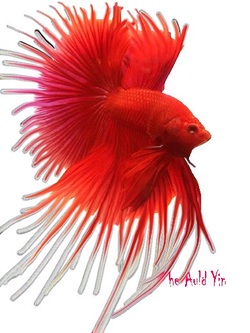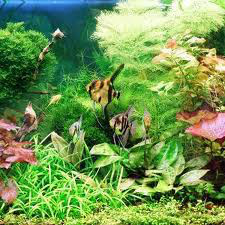My Website
Please visit my Studios at 1 Windabout Road Beechmont, Scenic Rim Qld.
Look for the signs; STUDIO OPEN. OR CALL 0416 o555 74
Or contact me at:
[email protected]

RECEIVED THIS ACKNOWLEDGMENT INSCRIBED ON THE BOOKS FLY WHICH WAS PRESENTED TO ME BY DR HERBERT AXELROD FOR THE WORK I HAVE DONE ON AQUARIUM ECOLOGY AND BREEDING WHILST I LIVED IN SCOTLAND. |
|

Just a wee reminder Siamese Fighters and all Fish are living beautiful creatures; look after them with due love and care.
I wrote this little piece of information some 40 years ago it may be slightly outdated but the basic information is still the same . I hope it may help save a few fishes lives when a beginner takes up this Hobby.
Alex Gardiner
TROPICAL FISH AND AQUARIUM ECOLOGY AND MAINTENANCE
I first began keeping tropical fish in 1950, which led me to studying about the breeding and ecology of these fish and their life in the aquarium.
I was involved in this activity until the age of 18 when I joined the Royal Signals where for 2 years I taught Teleprinting and tape relay theory .After I left the army I resumed my interest and activities with tropical fish.
Between this time and my leaving for Australia in 1969 I have managed one shop and opened up three of my own shops. Here I sold and gave information and advice on aquariums, fish breeding and aquarium ecology.
On arriving in Australia I commenced work at Nock & Kirby's, managing the tropical fish department. I also gave regular advice on Joe the Gadget Man's Channel 9 weekly "home" program. I subsequently opened a shop in a western Sydney location.
There are two main groups of "easy to keep" tropical fish; the egg-layers and the live-bearers i.e. fish which give birth to live young.
Some specialist aquarists have several different tanks, one tank of community fish i.e. varieties which live peacefully together. Not all tropical fish make good community fish, as some of them are bullies and damage or kill.
Start stocking your tank with egg-layers. Buy a few carefully selected pairs or several pairs of one variety, add more later, and then add some suitable live-bearers after the egg-layers are fully established.
Do not pick fish at random.
Select several varieties of tropical fish which generally swim in different areas of the tank, so that you get an overall colour picture rather than a crowded patch and empty spaces. For example, Zebras and other Danios, among the egg-layers, keep mainly to the top of the tank, and Tetras usually swim in the bottom third of the aquarium. Live-bearers swim as they please anywhere in the tank, and a couple of Catfish will complete the picture as they inhabit the bottom layer of your tank.
Suitable egg-layers for the community tank include Tetras, ( Neons, Glowlights, Serpae and Pretty Tetras) Barbs, Danios, Rasboras and Catfish.
Within limits, the setting up of a community tank is a matter of personal choice, but a guideline in selection for a nicely balanced 60cm aquarium would be twelve pairs of small varieties, including four to six Neon Tetras, four Zebra Danios, and a pair of Serpae to start with.
About one month later, add selected live-bearers, such as two Wagtail Platies or Moon Platies and a pair of Guppies. The latter will have a considerable number of young every six weeks in a well planted tank that is not over crowded. The male Guppies are brilliantly coloured with red, blue, black, green, and gold markings on their bodies. They usually measure just over 25mm at maturity. The female Guppies are olive or golden coloured with tailfin clear.
Mollies, Mollienisias are attractive , velvety black tropicals that grow in excess of 40mm long. They have the added attraction of being largely vegetarian in their diet, with a liking for algae. Mollies should not be kept in the same tank as tetras as they prefer slightly alkaline tank water, which does not suit the Tetras ( though few people take notice of this ).
Labyrinth Fish, so called because they have a cavity in their head with a labyrinth of fine veins for breathing, breathe at the surface for most of their oxygen instead of from the water, and are therefore, excellent community fish. The most popular of these Labyrinth Fish is the Gourami, and the beginner can certainly put a pair of Dwarf Gouramies in the tank once the original stock has settled in.
Add four Harlequins to your aquarium and you should have a display of community fish living in ideal conditions; not overcrowded yet filling the tank with colour and activity.
Some careful thought should be given before introducing the glamorous Angel Fish into a small tank with other fish. One reason for this is that they grow rather large compared with the average tropical community fish and, being showy, tends to detract from the other fish.
More importantly, there is no guarantee that they will get on with the smaller fish. Putting an Angel Fish into a community tank is rather like introducing a new cat to the house where there is a dog (or a new dog where there is a cat). The animals may get on well together, but they are unlikely to do so unless you buy a baby kittten of baby puppy, which does not arouse the jealousy of the other animal. While a very watchful eye should be kept on both animals in early days.
The same rules apply to Angel Fish and other similar fish that are likely to attack the smaller species. If you are determined to have a pair in your community tank, buy them when they are young and relatively small, and watch carefully to see how they get on with the rest of the fish in the tank. At the first sign of trouble, take them out immediately and put them in a different tank.
An unusual and useful tropical fish is the strange looking Catfish, which spends most of its time grubbing along the tank bed searching for bits of food. It has two barbels (see illustration)
or feelers, below the mouth, and can be had in a range of markings. It is an excellent bottom feeder. (Catfish are not scavengers in the true sense, but eat food generally off the bottom. They can only eat what they can).
As stated earlier, a beginner should stick to the simpler egg-layers and live-bearers, both for his or her sake and for that of the fish. However, once you have successfully kept and bred these fish, you may like to try your hand with the fascinating breeding of egg-scatterers and bubble-nest-builders.
Study the matter very carefully before moving into this specialized field, for it is difficult, and no one wants to spend money on unsuccessful breeding or to destroy fish needlessly. I would advise anyone who keeps fish as a hobby to join the local aquarium society. For a small annual fee, you can attend meetings to hear interesting lectures and get much valuable advice from the "old hands".
FEEDING FRESHWATER FISH
Tropical fish are not as greedy as goldfish, but they need to eat more frequently as they live in warmer water and they should be fed three to five times daily with minute quantities of varied foods.
As they mature, two to three meals will suffice, although there is no harm in keeping up the frequency of feeding. (I feed my fish every time I pass the aquarium if they are interested).
The amount fed at one meal should be very limited; you should drop a few grains of food into the tank, wait until it is eaten, usually a matter of seconds repeat the dose and wait again, and so on, until you think the fish have had enough.
Do not overfeed. The stomach of such a small fish is tiny. (Remember any food still in the aquarium after a few seconds will start to be leached by the water of any nourishment. Try to eat a biscuit under water before it dissolves! It's pretty impossible.//// It is impossible).
Normally, fish do not starve to death unless completely neglected for a very long time. In fact, they can occasionally be left for week without feeding if their conditions are as nearly ideal as humanly possible.
Just pouring food into the tank and leaving the fish to "get on with it" can only lead to rapid overeating, causing constipation in the fish, and to pollution of the water by waste food.
Regular foods should include one of the many reputable commercial staple foods (flake food), conditioning diets, nourishing diets, frozen brine shrimp, frozen tubifex worms, and maybe some of the freeze dried foods.
Some fish are largely vegetarian and these are catered for with prepared vegetable foods available at most pet shops. Mollies, the most popular of vegetarians, should be kept where algae grows freely. They also like finely chopped boiled spinach for a change.
RULE 1. FISH WILL ONLY EAT WHAT THEY CAN.
RULE 2. FISH WILL EAT AS MANY TIMES AS YOU CAN FEED THEM.
RULE 3. YOU CAN FEED THEM AS MANY TIMES AS YOU WANT.
RULE 4. ANY FOOD IN EXCESS OF WHAT THEY CAN EAT IMMEDIATELY WILL ADD UP AND FOUL THE AQUARIUM.
RULE 5. IN REAL LIFE, FISH BROWSE ALL DAY DURING DAYLIGHT. TRY TO COPY THIS IF YOU CAN.
RULE 6. FISH WILL THRIVE ON A VARIETY OF LIVE AND DRY FOODS AND WILL ALSO BROWSE ON PLANTS AND ALGAE.
RULE 7. REMEMBER, YOU CAN ALWAYS ADD MORE FOOD TO THE AQUARIUM BUT IT IS DIFFICULT TO EXTRACT FOOD WHEN TOO MUCH IS GIVEN AT THE ONE TIME.
RULE 8. FEED FREQUENTLY AND FISH WILL THRIVE . IF YOU DO NOT THEY WILL ONLY SURVIVE (MAYBE)?
RULE 9. THIS FEEDING ADVICE IS TO BE USED IN CONJUNCTION WITH PROPER MAINTENANCE .
RULE 10 AND FINAL RULE. IT IS THE FISH THAT NEED THE NOURISHMENT OUT OF THE FOOD NOT THE AQUARIUM.
THE INITIAL SET UP WILL TAKE FIVE WEEKS TO ATTAIN THE PROPER NITRATE"NITRITE CYCLE.
SOME OF THE WATER SHOULD BE CHANGED WEEKLY. THE AMOUNT CHANGED SHOULD BE ONE FIFTH OF THE TOTAL VOLUME. THIS AMOUNT SHOULD BE SIPHONED FROM THE BOTTOM OF THE AQUARIUM AGITATING THE GRAVEL LAYER TO ACCESS SURPLUS DEBRIS. THIS AGITATION SHOULD BE DONE AFTER THE FIFTH WEEK AND DONE WITH EACH WATER CHANGE .
THIS AGITATION SHOULD NOT BE DONE IN WELL ESTABLISHED AQUARIUMS AS THE BUILD UP OF GASES MAY BE TOO MUCH TO RELEASE INTO THE AQUARIUM WATER; THAT IS TO SAY IF THIS ESTABLISHED AQUARIUM HAS NOT HAD THE GRAVEL AREA DISTURBED SINCE THE INITIAL SETUP.
This posting is only a small beginning in the proper maintenance of a Home Aquarium. I hope it helps those who require help and encourages others more
experienced to do the same. A little help to beginners goes a long way.
Alex Gardiner .

